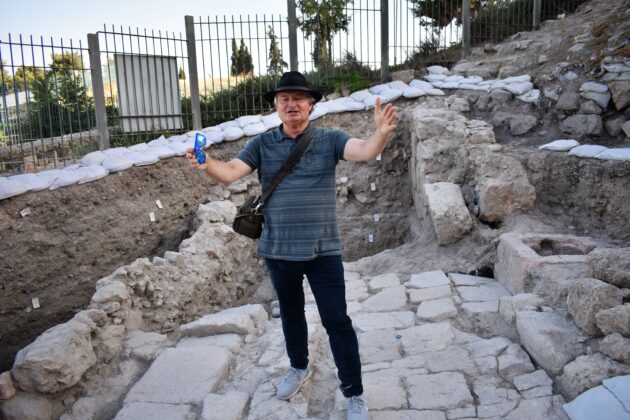
One month after offering up archaeological evidence to back up a contested claim about the First Crusade, researchers say they’ve found traces of the Babylonian conquest of Jerusalem in a deeper layer of their excavation on Mount Zion.
The newly reported find demonstrates how the site, just outside the walls of the Old City’s Tower of David citadel, serves as a “time machine” documenting the twists and turns of Jerusalem’s history.
The Babylonian conquest, which dates to the year 587 or 586 BCE, is one of the major moments of Jewish history. As detailed in the biblical Book of Kings, the Babylonians laid siege to Jerusalem for months, eventually broke through the walls and burned “all the houses of Jerusalem,” including Solomon’s Temple.
After the fall of Jerusalem, the Jewish people were sent into exile – an event that Jews commemorate with mourning and fasting every year on the ninth day of the Hebrew month of Av. This year’s Tisha B’Av observance began at sundown tonight.
During this year’s Mount Zion excavation, which is managed by the University of North Carolina at Charlotte, researchers came across a layer of material that included burnt wood and ash, potsherds, lamps and arrowheads dating from the time of the conquest. They also found a piece of period jewelry – a tassel or earring made of gold and silver.

An area around the dig yielded up signs of what appears to have been a substantial Iron Age structure, but that particular area has yet to be fully excavated.
Today, the focus of the Mount Zion Archaeological Project is a triangular wedge of ground that lies between a busy Jerusalem thoroughfare and the citadel’s walls. But at the time of the Babylonian siege, the area was a neighborhood within the fortifications of the Iron Age city, said Shimon Gibson, a co-director of the excavation and a professor of history at UNC Charlotte.
By itself, the ash wouldn’t serve as conclusive evidence of the city’s biblical destruction, Gibson said.
“For archaeologists, an ashen layer can mean a number of different things,” he explained in a news release. “It could be ashy deposits removed from ovens, or it could be localized burning of garbage.”
But the fact that the ash and debris were mixed with Scythian-type bronze and iron arrowheads that date to the sixth century BCE, plus the presence of a precious bauble from the same era, helps strengthen the case.
“Nobody abandons golden jewelry, and nobody has arrowheads in their domestic refuse,” Gibson said.
The clay artifacts, which include the high-based pinched lamps that were common at the time of the siege, help to date the deposit.
“It’s the kind of jumble that you would expect to find in a ruined household following a raid or battle,” Gibson said. “Household objects, lamps, broken bits from pottery which had been overturned and shattered … and arrowheads and a piece of jewelry which might have been lost and buried in the destruction.”

Gibson said he likes to think that the site represents one of the “great houses” mentioned in 2 Kings 25:9. “This spot would have been at an ideal location, situated as it is, close to the western summit of the city with a good view overlooking Solomon’s Temple and Mount Moriah to the northeast,” he said.
But he and the rest of the team are proceeding carefully.
“We are slowly taking the site down, level by level, period by period, and at the end of this last digging season, two meters of domestic structures from later Byzantine and Roman periods have still to be dug above the Iron Age level below,” Gibson said. “We plan to get down to it in the 2020 season.”
Excavation co-director Rafi Lewis, an archaeologist at Ashkelon Academic College and Haifa University, said the historical context that surrounds the discoveries at the Mount Zion site adds to the project’s appeal.
“It is very exciting to be able to excavate the material signature of any given historical event, and even more so regarding an important historical event such as the Babylonian siege of Jerusalem,” he said in the news release.
This season’s other notable discovery relates to another battle at Jerusalem’s walls – the siege by the Crusaders in 1099. The UNC Charlotte team excavated the outlines of a defensive ditch that, combined with artifacts including arrowheads, crucifixes and a piece of jewelry found amid a layer of burned debris, served to confirm a long-debated chapter in the saga of the First Crusade.
The team also uncovered vaulted basements dating from the time of Herod the Great, and a Byzantine street that was the continuation of a thoroughfare in Jerusalem known as the Cardo Maximus. Previous finds at the site include a rare gold coin bearing the visage of Nero as a young Roman emperor, and a first-century Jewish mansion that came complete with a bathtub.
The Mount Zion archaeological project is conducted by researchers, students and volunteers under the direction of Gibson, Lewis and James Tabor, a professor of religious studies at UNC Charlotte. The site is within an Israeli national park near the Old City’s Zion Gate. The project’s sponsors include Aron Levy, John Hoffmann, Cherylee and Ron Vanderham, Patty and David Tyler. Sheila Bishop of the Foundation for Biblical Archaeology is a facilitator for the project.
GeekWire’s Alan Boyle traveled to the Mount Zion site last month as part of a field trip associated with the World Conference of Science Journalists and organized by CERN with support from the Open SESAME consortium.
via GeekWire
Archaeological dig in Jerusalem unearths evidence of biblical Babylonian conquest